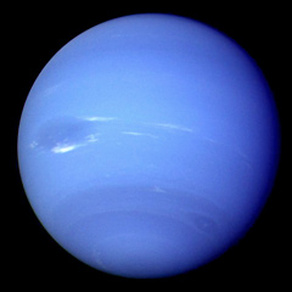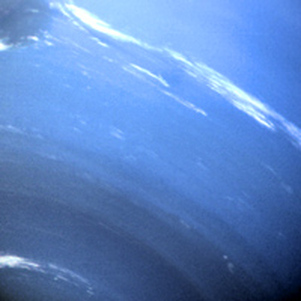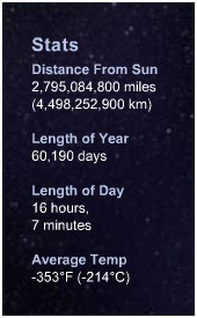Our Solar System
Planet Neptune

Neptune is currently the most distant planet from the Sun, with an orbital radius of 30 Astronomical Units and an orbital period of 165 years. Its diameter is about four times that of the Earth, which makes it the 4th largest planet. It is slightly smaller than Uranus, but its density is 1.6 g/cc (compared with 1.2 g/cc for Uranus), which makes it the 3rd most massive planet. The relatively low density indicates large concentrations of hydrogen and helium, but Uranus and Neptune both have much larger concentrations of heavier elements than Jupiter and Saturn. As for all the gas giant planets, models suggest rocky cores of maybe 15 Earth masses, but there is no direct confirmation of this.
The Neptune rotation period is about 16 hours, comparable to that of Uranus and much slower than for Jupiter and Saturn. The temperatures at the cloud tops are about -216 degrees Celsius, slightly warmer than for Uranus. Neptune, like Jupiter and Saturn but unlike Uranus, has an internal heat source and produces 2.7 times more heat than it absorbs.
The Neptune rotation period is about 16 hours, comparable to that of Uranus and much slower than for Jupiter and Saturn. The temperatures at the cloud tops are about -216 degrees Celsius, slightly warmer than for Uranus. Neptune, like Jupiter and Saturn but unlike Uranus, has an internal heat source and produces 2.7 times more heat than it absorbs.
Neptune's Atmosphere

The atmosphere of Neptune is similar to all the large planets in the Solar System; it mostly consists of hydrogen and helium, with trace amounts of methane, water, ammonia and other ices. But unlike the other gas planets in the Solar System, Neptune’s atmosphere has a larger proportion of the ices. It’s the methane in the planet’s upper atmosphere that give it its bright blue color.
At the highest altitudes, where the Neptune’s atmosphere touches space, it consists of about 80% hydrogen and 19% helium. There’s also a trace amount of methane. The light we see from Neptune is actually the reflected light from the Sun. Although the entire spectrum of light hits Neptune. This trace amount of methane absorbs light from the red end of the spectrum, while allowing the blue light to bounce back out. The color of Neptune’s atmosphere is brighter than Uranus, which has a similar atmosphere; astronomers aren’t sure why there’s such a dramatic color difference.
The upper level clouds on Neptune occur at the point where pressures are low enough for methane to condense. Astronomers have photographed these high altitude clouds forming shadows onto the lower cloud deck below. Deeper down inside Neptune, temperatures should get up to 0 C, where clouds of water might form.
As with the other planets, the atmosphere of Neptune is broken up into distinct bands of storms. In fact, the fastest moving winds in the Solar System occur at Neptune – winds have been clocked at 2,400 km/h (1,500 miles per hour). Some storms can grow large and remain for long periods of time. Neptune has its own Great Dark Spot, similar to the Great Red Spot on Jupiter.
At the highest altitudes, where the Neptune’s atmosphere touches space, it consists of about 80% hydrogen and 19% helium. There’s also a trace amount of methane. The light we see from Neptune is actually the reflected light from the Sun. Although the entire spectrum of light hits Neptune. This trace amount of methane absorbs light from the red end of the spectrum, while allowing the blue light to bounce back out. The color of Neptune’s atmosphere is brighter than Uranus, which has a similar atmosphere; astronomers aren’t sure why there’s such a dramatic color difference.
The upper level clouds on Neptune occur at the point where pressures are low enough for methane to condense. Astronomers have photographed these high altitude clouds forming shadows onto the lower cloud deck below. Deeper down inside Neptune, temperatures should get up to 0 C, where clouds of water might form.
As with the other planets, the atmosphere of Neptune is broken up into distinct bands of storms. In fact, the fastest moving winds in the Solar System occur at Neptune – winds have been clocked at 2,400 km/h (1,500 miles per hour). Some storms can grow large and remain for long periods of time. Neptune has its own Great Dark Spot, similar to the Great Red Spot on Jupiter.

